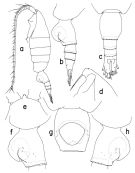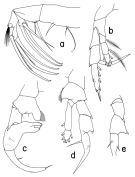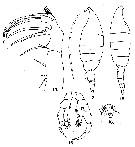|
|
 |
|
Calanoida ( Order ) |
|
|
|
Arietelloidea ( Superfamily ) |
|
|
|
Heterorhabdidae ( Family ) |
|
|
|
Heterorhabdus ( Genus ) |
|
|
| |
Heterorhabdus prolatus Park, 2000 (F,M) | |
| | | | | | | Syn.: | Heterorhabdus papilliger: Grice, 1962 (p.222, figs.M, no F), after Park (2000, p.110) | | | | Ref.: | | | Park, 2000 (p.109, figs.F,M, Rem.) |  issued from : T. Park in Bull. Scripps Inst. Oceanogr. Univ. California, San Diego, 2000, 31. [p.230, Fig.78]. Female: a, habitus (left side); b, c, urosome (left, dorsal, respectively); d, e, forehead (left, dorsal, respectively); f, g, h, genital somite (left, ventral, right, respectively). Nota: - Prosome length 70 % length of body and about 2.3 times length of urosome. - Forehead angular and produced ventrad into a small rostrum bearing 2 slender filaments. dorsally, midanterior tubercular process (fig.78 e) tapering into a pointed tip. - Cephalosome 46 % length of prosome, with a cervical groove halfway along dorsal margin - Posterolateral corner of prosome rounded. - Length ratios of 4 urosomal somites and left caudal ramus 38.8 : 18.7 : 13.7 : 8.8 : 20.0 = 100. - Left caudal ramus extending beyond posterior end of right ramus by about 1/5 its length( as measured along medial margin). Dorsal appendicular seta of left ramus almost twice as long as that of right ramus.; 4th marginal seta of left ramus much thicker than other marginal setae and longer than body. Dorsally, each caudal ramus with a relatively large pore. - A1 reaching close to posterior end of caudal ramus.
|
 issued from : T. Park in Bull. Scripps Inst. Oceanogr. Univ. California, San Diego, 2000, 31. [p.231, Fig.79]. Female: a, left Mx2 (posterior); b, P5 (anterior). Nota: Mx2: Falcate spine of 5th lobe with proximal 54 % of medial margin serrated with spinules; falcate spine of 6th lobe with proximal 63 % of medial margin serrated with spinules. (compare with H. spinifer fig.76 g). Male: c, right P5 (endopod omitted), anterior; d, left P5 (anterior); e, exopod of P5 (anterior). Nota male: - Prosome 71 % length of body; urosome 30 % length of body. - First 4 urosomal somites armed with relatively large spinules along posterior margins. - Caudal rami and setation as in female.
|
 issued from : G.D. Grice in Fish. Bull. Fish and Wildl. Ser., 1962, 61. [p.221, Pl.24, Figs.13-16]. As Heterorhabdus papilliger. Male (from equatorial Pacific): 13, habitus (lateral); 14, Mx2; 15, P5; 16, distal end of protrusion of 2nd exopodal segment of right P5.
|
 Heterorhabdus prolatus Heterorhabdus prolatus female: 1 - See key to species groups of Heterorhabdus: ''papilliger'' Group (p.90, 102). 2 - Midanterior tubercular process of forehead produced into an angular process (Fig.78-e) and not produced into a spiniform process. P5 with inner marginal seta on 1st endopodal segment (Fig.79-b). 3 - Laterally, genital prominence extending far shorter to posterior end of somite (Fig.78-b).
|
 Heterorhabdus prolatus Heterorhabdus prolatus male: 1 - See key to species groups of Heterorhabdus: ''papilliger'' Group (p.90, 102). 2 - Midanterior tubercular process of forehead angular and not produced into a spiniform process. Basal inner lobe of left P5 rather poorly developed and angular distally (Fig.79-d) 3 - In right P5, medial projection of 2nd exopodal segment not terminally expanded, somewhat truncate, with nearly parallel proximal and distal sides (Fig.79-c).
| | | | | NZ: | 4 | | |
|
Distribution map of Heterorhabdus prolatus by geographical zones
|
| | | | | | | Loc: | | | S Mozambique, W Indian, NE Indian (equatorial), Indonesia-Malaysia, China Seas (South China Sea), Pacif. (equatorial: E-W), E Pacif. tropical
Type locality: 14°46'S, 93°37'W.
For Park (2000, p.110), this species is apparently an equatorial species of the Indo-Pacific. | | | | N: | 2 | | | | Lg.: | | | (101) M: 2,11-1,7; (824) F: 2,14-1,78; M: 2,14-1,8; {F: 1,78-2,14; M: 1,70-2,14} | | | | Rem.: | "Papilliger" Group. | | | Last update : 20/05/2017 | |
|
|
 Any use of this site for a publication will be mentioned with the following reference : Any use of this site for a publication will be mentioned with the following reference :
Razouls C., Desreumaux N., Kouwenberg J. and de Bovée F., 2005-2026. - Biodiversity of Marine Planktonic Copepods (morphology, geographical distribution and biological data). Sorbonne University, CNRS. Available at http://copepodes.obs-banyuls.fr/en [Accessed January 07, 2026] © copyright 2005-2026 Sorbonne University, CNRS
|
|
 |
 |






